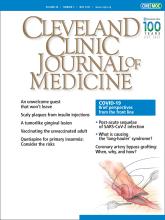Article Figures & Data
Tables
Vaccine Dosing Contraindications Precautions Tetanus, diphtheria, acellular pertussis (TDaP) 3 doses: 1–2 months between doses 1 and 2 and 6–12 months between doses 2 and 3
Give TD booster every 10 years after initial regimen completedPrior severe allergic reaction to the vaccine or its components Moderate or severe acute illness with or without fever
For pertussis-containing vaccines only, in patients with progressive or unstable neurologic disorder, uncontrolled seizures, or previous encephalopathy, defer use until a treatment regimen has been established and the condition stabilizesMeasles, mumps, rubella (MMR) Give 1 dose if born in 1957 or later
Give 2 doses (no sooner than 4 weeks after initial dose) to high-risk groups:
Any healthcare personnel
Students entering college
International travelers
If pregnant, MMR should be given postpartumPrior severe allergic reaction to the vaccine or its components
Pregnancy or possible pregnancy within 4 weeks
Severe immunodeficiency (hematologic and solid tumors, active chemotherapy, congenital immunodeficiency, HIV with severe immunocompromise)Moderate or severe acute illness with or without fever
If blood, plasma, and/or immunoglobulin were given in the last 11 months, follow the ACIP best practices14
History of thrombocytopenia or thrombocytopenic purpuraVaricella (chicken-pox) Give 2 doses: second dose 4–8 weeks after first dose; if delayed, do not start over, just give second dose Prior severe allergic reaction to the vaccine or its components
Pregnancy or possible pregnancy within 4 weeks
People who are on long-term immunosuppression or are immunocompromised
Vaccine can be considered in patients with CD4 count ≥ 200 cells/mm3Moderate or severe acute illness with or without fever
If blood, plasma, and/or immunoglobulin were given in last 11 months, follow ACIP best practices14
Recipient of specific antivirals (acyclovir, famciclovir, valacyclovir) 24 hours before vaccination
Use of aspirin-containing products as there is an increased risk of Reye syndromeACIP = Advisory Committee on Immunization Practices (part of the US Centers for Disease Control and Prevention); HIV = human immunodeficiency virus Adapted from reference 16.
Vaccine Indications Dosing Contraindications Hepatitis A Desire to be protected from hepatitis A virus (HAV)
Travel or work outside of United States
Chronic liver disease, use of injected or noninjected drugs, homeless, receiving clotting-factor concentrates, works with HAV in laboratory, food handlers when appropriate
Close contact with international adoptee from country where HAV is endemic during the first 60 days after adoptee’s arrival
2 doses, 6–18 months apart depending on brand
If second dose is delayed, do not start over, just give dosePrior severe allergic reaction to the vaccine or its components
Cautions: Moderate or severe acute illness with or without feverHepatitis B Wants to be protected from hepatitis B virus
Has close household contact of hepatitis B surface antigen-positive people, chronic liver disease, injects drugs, sexually active with multiple partners, male who has sex with men, human immunodeficiency virus-positive, hemodialysis patients or may soon need dialysis, diabetes and younger than 60
Is a healthcare worker or person exposed to blood, inmates of long-term correctional facilities
Heplisav-B: 2 doses, 1 month apart Engerix-B and Recombivax HB: 3 doses (1 mL each) at 0, 1, 6 months
If patient is receiving hemodialysis or is immunocompromised:
Recombivax HB: 1 dose of 4 mL at 0, 1, 6 months
Engerix-B: 2 doses of 2 mL given simultaneously at 0, 1, 2, 6 months
Heplisav-B: 2 doses 1 month apart
If schedule delayed, do not start over, continue from where schedule was interruptedPrior severe allergic reaction to the vaccine or its components
Cautions: Moderate or severe acute illness with or without feverHaemophilus influenzae type B Anatomic or functional asplenia
Undergoing elective splenectomy
Received a hematopoietic stem cell transplant (HSCT)
Give 1 dose of any H influenzae type B conjugate vaccine
If received HSCT, 3 doses at least 4 weeks apart beginning 6–12 months after transplantPrior severe allergic reaction to the vaccine or its components
Cautions: Moderate or severe acute illness with or without feverInactivated polio Plans to travel to areas where exposure to wild-type virus is likely 0, 2, 4, 16 months
4–6 year schedule with minimum interval of 4 weeks between dosesPrior severe allergic reaction to the vaccine or its components
Cautions: Moderate or severe acute illness with or without fever; pregnancyMeningococcal conjugate Student younger than age 21 living in residence hall
Has anatomic or functional asplenia, is HIV-positive, or has persistent complement component deficiency
Travel to countries where meningococcal disease is endemic
Microbiologist routinely exposed to isolates of Neisseria menningitidis
If college student age 19–21 living in residence hall, give 1 dose
If asplenic, give 2 initial doses at 0 and 2 months with booster every 5 years
If traveling or has exposure risk, give 1 initial dose with booster every 5 yearsPrior severe allergic reaction to the vaccine or its components
Cautions: Moderate or severe acute illness with or without feverMeningococcal sero-group B Anatomic or functional asplenia or persistent complement component deficiency
Microbiologist routinely exposed to isolates of N menningitidis
At risk because of a serogroup B meningococcal outbreak
Bexsero at 0 and 1 months
OR
Trumenba at 0, 1–2, and 6 monthsPrior severe allergic reaction to the vaccine or its components
Cautions: Moderate or severe acute illness with or without feverAdapted from reference 16.






